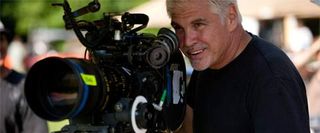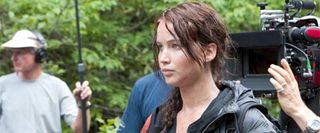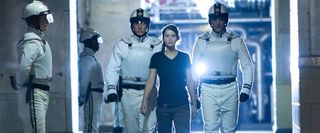Hunger Games Director Gary Ross Talks Handling The Phenomenon

There is no movie out there that is exactly the same as the book it was based on. Whether it’s because an element doesn’t work cinematically or because things have to be cut for time, there will always be differences between source material and film. But what do you do when the material you’re adapting is held precious by millions and is very much part of a phenomenon? That’s exactly what Gary Ross had to deal with while making The Hunger Games.
A few weeks back I was invited to participate in a series of roundtables with the cast and filmmakers behind the Suzanne Collins adaptation including its writer/director. Check out our interview below in which Ross not only talks about adding to and cutting the source material, what it was like working closely with the original author, and why the PG-13 rating didn’t hamper him in any way.
It’s fascinating. Everyone we’ve talked to loves the movie. You’ve clearly assembled a group of people that don’t just love the job, but love the material and are excited about it.
I had a great cast. It’s great and that’s one if the fun things about being a director is that you put a company together. You put your little rep company together. In this case we all went off to the woods together. We all lived in Nashville over the summer, we all knew each other, and we all hung out together. These are astoundingly talented actors, so it’ thrilling to be in a creative environment like that and we all had a great time. I tend to love actors. I was trained as an actor first so I’m drawn to actors. I think they have the hardest job on the movie. You have to pretend that 250 people aren’t looking at you and muster the truth in an unselfconscious way. And what most people are doing on a movie set is fairly technical and what an actor is doing on a movie set is fairly ephemeral. It cannot happen in an instant. But this group was wonderful.
This movie is already a phenomenon but when you’re developing the script knowing that you have this fan base, you can’t have a pure adaptation, so where do you draw the line at what you can include and what you don’t include?
I mean I love the book. I wouldn’t have thrown my hat in if I didn’t. So when I read it I wanted to do a faithful adaptation, as faithful an adaptation as I could because I dug the source material. It’s not like I wanted a point of departure, having said that there’s obviously a translation from one medium to another. But Suzanne [Collins] understands that and I did the final draft of the script with her. So somebody asked me about Peter Jackson and how he handled the fans and his departure from The Lord of the Rings and I said, ‘well I was lucky enough to have JRR Tolkien in the room with me.’ So I wrote a draft that I sent to Suzanne, she loved the draft, she came out and we talked. She has a lot of ideas that were great and we started working together on the last draft. So this reflects our work together. So I felt pretty confident in the departures I would make.

Are there things that you shot that would end up on an extended edition of The Hunger Games?
CINEMABLEND NEWSLETTER
Your Daily Blend of Entertainment News
It’s so funny because everybody asks about the director’s cut. This is the director’s cut. It’s not like anybody is making me take stuff out. I don’t believe in the inclusion of extra scenes. I was always bummed when Francis [Ford Coppola] showed everybody the scene from the French dinner party in Apocalypse Now. It’s like, no man I want to see what you and Richard Marx did in that movie. So, I don’t even really believe in the inclusion of extra scenes. Yeah, there’s stuff that I did that I like, things we shot that didn’t make it in. There was one whole scene in the woods that was between Prim and Gale that I thought was like a tender little moment and some stuff in the training center that didn’t make it in. But I think the movie should stand up on its own.
Working with Suzanne on the script there had to have been a moment where you disagreed.
You know it wasn’t really like that. We both saw challenges. We both saw translation issues. I was interested to hear from her about what things were necessary, fresh eyes from the woman who had created the whole thing. It was a very collegial conversation. We started working together before I invited her in to do the draft. And I don’t think I would have done that if it hadn’t felt so good working together.
You have a great visual aesthetic. It almost is a musical aesthetic with very distinct musical patterns. How did you go about achieving that?
Phil [Desena] is actually someone who I met through my friend Steven Soderbergh. I loved the stuff that he’d done on Steven’s stuff. Erin Brockovich, I love the design of that movie and the Oceans movies. Phil and I talked about some other movies prior to this and the seam is the seam. We know what that’s all about. And we were lucky enough to be shooting in North Carolina where we found an abandoned mill town that had 27 of these worker houses that had been built around the 1930’s and it had an old dam with a turbine and things that just worked perfectly for the movie to evoke the scene. It was like finding a backlot so we just got very lucky that way. In terms of the Capital we were inventing something so the first thing was it had to have authority, it had to have power, it had to have might. It couldn’t feel dreamed up in a computer. I wanted it to be set in the future but have a sense of its own past. So I had to find the building materials, concrete at first. So I looked at a lot of palaces in Lassa and Tibet that had these blank concrete edifices and were very imposing. That brought Phil to a period of mid-century architecture that’s come to be known as brutalism. Which are these blank concrete edifices that are imposing. We thought about seats of power in the world and the fact that they all rely on open space. They’re never tall or soaring. That’s kind of joyous, right? New York City, right? It has a happy, huge, soaring skyline that goes up to the heavens. But any seat of power is about horizontal space, open space: Tiananmen Square, Red Square, that’s how you establish, might and authority, you get away from it. So we riffed off that and a little bit of Albert Speer. We studied Leni Riefenstahl and things like that. Because this place had to feel real, it’s the antagonist of the piece. It has to have a certain kind of power and I know that the Capital feels like a circus, it’s festive and alluring and indulgent and decadent but it also has to have the kind of might and power behind it so that informed those decisions.

I think the great thing about science fiction is that everyone has to make a decision about their future world. What was the key for you in determining the look of the Capital and its citizens?
Again that It’s this wild carnival that will feel real, that the decadence feels real. That was the touchstone with everything. And I had incredibly talented people. I mean Ve Neill, my make-up artist, has been nominated for nine Oscars and won three. I mean this lady really knows what she’s doing. So these are collaborations with talented people. But what I wanted to do was have it be bent and a little twisted. My reference for shooting Effie was Joel Grey in Cabaret. I wanted to get inside that make-up and see every pore and see every hair. I wanted it to be grotesque. When you shoot her from out there and she’s front lit she looks like a stage performer. When you shoot her from in here you’re seeing the burden of the make-up that she packs on every morning and I wanted to get behind that veil and behind the public presentation of it was to get to the grotesque. And we tried to find that balance in the Capital as well.
The book is about violence, but you do have a PG-13 rating. Did you ever feel handcuffed?
No, because I wouldn’t have shot this any differently regardless of the rating. I think that the MPAA had an issue with one or two shots. There was one tighter shot that I cut to a wider shot. It was so minor that it was almost insignificant really. It’s a nice synergy because I’m shooting in Katniss’ point of view. And because I’m in her point of view the hits of violence that you experience are so subjective to her that I’m not cutting wide to indulge a set piece of violence and then back to Katniss. I’m in Katniss’ perception of that. And so I don’t need to graphically indulge or exploit that violence. I’m seeing her perception of it and as long as I’m invested in her perception. And as long as I’m invested in her point of view a little goes a very long way in terms of her experience of what that’s like. And you guys have seen it it’s not like we backed off the violence in the Cornucopia. It’s pretty explicit but it doesn’t need to be indulgent in order to be explicit. Because I’m on her, I’m not on it. I’m on her as she perceives it and I’ll show it and we don’t back off it but at the same time the whole movie is about her perception. Including the sound, including the music, I mean everything.

Do you become very conscious of Katniss’ point of view in the editing room in terms of how long you can or cannot get away from her.
Oh, completely. I mean you’re in her point of view and even when I cut away to that game center I’m doing what Suzanne did in the character’s head. I mean Suzanne writes “Oh, I know the game makers are messing with me right now. They’re doing X,Y and Z.” Well I have the ability in the movie to be able to cut to that. Where in a first person narrative you can’t. So I’m really just doing what’s in the book anyway. So I’m able to show something that’s in the novel is just imagined. I think it was still within Katniss’ storyline to cut to Liam seeing that kiss for example. And the game makers were an integral part of Katniss’ storyline but I’m never leaving what’s going on with her for very long because I need to stay and keep you invested in what’s happening to her. If you’re in Katniss’ shoes and I cut to the game makers messing with her and I cut back to Katniss you’re still in Katniss’ shoes. You’re still in her process and her thought process and going through her experience. I’m enhancing that in the cut away; I’m not digressing from that. So that was really the criteria in how I did it.
With so many characters in this what were the biggest challenges in assembling this whole cast knowing that so many people have their own perceptions?
I mean look, I was a fan before I was the director. I love the books too. I can’t make a movie in a way other than pleasing myself and my own judgment. That’s all a director has. All we have is our take on it. I can’t really worry about or guess what 23 million different opinions are. And so I have to trust my own gut and what I think is going to work. But these were all amazing actors and in terms of calibrating what the whole cast is, that’s a process where you have to look at everybody together and see how this world fits together. Does the tone break anywhere? Do they homogenize and harmonize well? So that’s really what that process is. I didn’t feel a tremendous amount of pressure about what the fans would think because I thought I was being faithful to the book and therefore to what the fans would want and I was talking to Suzanne throughout the casting process as well.

Eric Eisenberg is the Assistant Managing Editor at CinemaBlend. After graduating Boston University and earning a bachelor’s degree in journalism, he took a part-time job as a staff writer for CinemaBlend, and after six months was offered the opportunity to move to Los Angeles and take on a newly created West Coast Editor position. Over a decade later, he's continuing to advance his interests and expertise. In addition to conducting filmmaker interviews and contributing to the news and feature content of the site, Eric also oversees the Movie Reviews section, writes the the weekend box office report (published Sundays), and is the site's resident Stephen King expert. He has two King-related columns.
Most Popular





